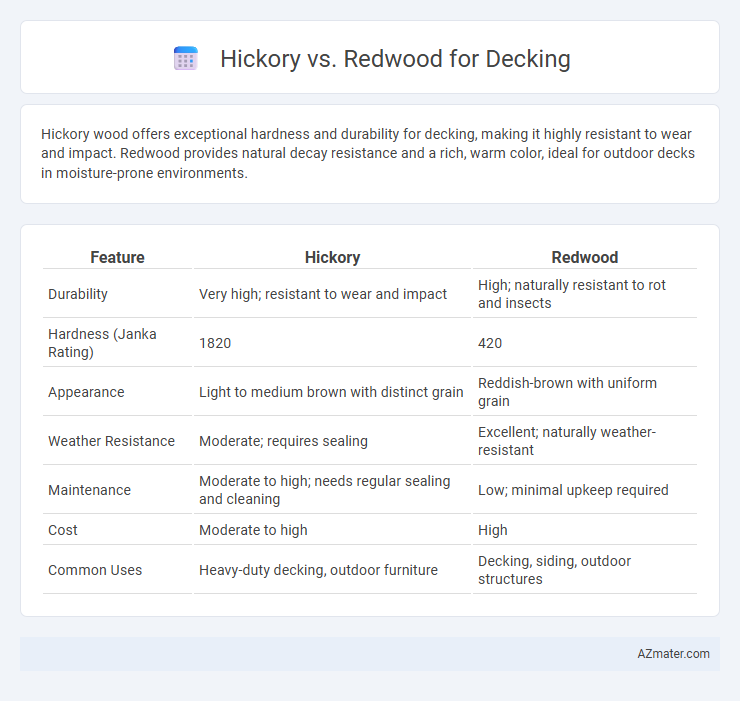Hickory wood offers exceptional hardness and durability for decking, making it highly resistant to wear and impact. Redwood provides natural decay resistance and a rich, warm color, ideal for outdoor decks in moisture-prone environments.
Table of Comparison
| Feature | Hickory | Redwood |
|---|---|---|
| Durability | Very high; resistant to wear and impact | High; naturally resistant to rot and insects |
| Hardness (Janka Rating) | 1820 | 420 |
| Appearance | Light to medium brown with distinct grain | Reddish-brown with uniform grain |
| Weather Resistance | Moderate; requires sealing | Excellent; naturally weather-resistant |
| Maintenance | Moderate to high; needs regular sealing and cleaning | Low; minimal upkeep required |
| Cost | Moderate to high | High |
| Common Uses | Heavy-duty decking, outdoor furniture | Decking, siding, outdoor structures |
Introduction to Hickory and Redwood Decking
Hickory decking offers unparalleled durability and hardness, making it highly resistant to dents, wear, and heavy foot traffic, ideal for long-lasting outdoor spaces. Redwood decking stands out for its natural resistance to decay and insects, featuring a rich reddish hue that enhances aesthetic appeal and requires minimal maintenance. Both wood types provide excellent options for decks, with hickory excelling in strength and redwood prized for its beauty and natural resilience.
Durability Comparison: Hickory vs. Redwood
Hickory offers exceptional hardness and resistance to wear, making it highly durable for decking in high-traffic areas. Redwood, naturally rich in tannins and resins, provides excellent resistance to rot, decay, and insect damage, ensuring longevity in outdoor environments. While hickory boasts superior strength and impact resistance, redwood excels in moisture resistance, making it more suitable for wet or humid climates.
Appearance and Aesthetic Differences
Hickory decking features a unique, varied grain pattern with rich, warm tones ranging from pale yellow to deep brown, creating a rustic and dynamic visual appeal. Redwood offers a consistent, straight grain with striking natural red hues that deepen over time, providing a classic, elegant look ideal for traditional and contemporary outdoor spaces. The contrasting textures and colors between hickory's rugged complexity and redwood's smooth uniformity significantly influence the overall aesthetic of a deck.
Weather and Decay Resistance
Hickory offers exceptional hardness and wear resistance but has moderate weather and decay resistance, requiring regular sealing to maintain durability in outdoor decking. Redwood naturally contains tannins and oils that provide superior weather resistance and decay protection, making it a preferred choice for decks exposed to moisture and varying climates. Choosing redwood reduces maintenance needs and extends deck lifespan compared to hickory in harsh weather conditions.
Maintenance Requirements for Each Wood
Hickory decking demands regular sealing and staining due to its high density and susceptibility to moisture absorption, which helps prevent cracking and warping. Redwood, known for its natural resistance to decay and insects, requires less frequent maintenance but still benefits from annual cleaning and occasional sealing to maintain its color and durability. Proper maintenance schedules for both woods extend decking lifespan, with hickory needing more attentive care compared to the relatively low-maintenance redwood.
Cost Analysis: Hickory vs. Redwood
Hickory decking typically costs between $10 to $15 per square foot, making it a more economical choice compared to redwood, which ranges from $15 to $25 per square foot due to its premium status and natural resistance to decay. Installation expenses are similar for both woods, but redwood's durability can reduce long-term maintenance costs, potentially offsetting its higher initial price. Considering both upfront material costs and lifecycle expenses provides a comprehensive cost analysis for choosing between hickory and redwood decking.
Environmental Impact and Sustainability
Hickory decking is less sustainable due to slower growth rates and higher land use, contributing to greater environmental impact compared to redwood. Redwood is a more eco-friendly choice, often sourced from sustainably managed forests with certifications like FSC, promoting faster regeneration and biodiversity preservation. Its natural resistance to decay reduces the need for chemical treatments, enhancing its sustainability profile over hickory in decking applications.
Installation Considerations
Hickory decking requires thorough acclimation due to its high density and tendency to expand or contract with moisture changes, necessitating precise spacing and fasteners rated for hardwoods to prevent splitting. Redwood, being naturally resistant to decay and relatively stable, allows for easier installation with standard decking screws and less concern over movement, reducing long-term maintenance needs. Proper installation of both materials demands consideration of local climate conditions to ensure durability and performance over time.
Lifespan and Long-Term Value
Hickory decking offers exceptional hardness and durability with a lifespan of around 15-25 years when properly maintained, making it resistant to dents and wear. Redwood, known for its natural resistance to decay and insect damage, can last 25-30 years or more, providing long-term value through minimal maintenance and its inherent stability. Investing in redwood decking often yields higher long-term value due to its longevity and reduced upkeep costs compared to hickory.
Pros and Cons Summary
Hickory decking offers exceptional hardness and durability, making it highly resistant to dents and wear, but it requires regular sealing to prevent moisture damage and warping. Redwood provides natural rot resistance and rich color tones that enhance outdoor aesthetics, yet it is softer than hickory and more prone to scratches and dents. Both woods can be excellent choices depending on budget and maintenance preferences, with hickory excelling in strength and redwood favored for its natural beauty and decay resistance.

Infographic: Hickory vs Redwood for Decking
 azmater.com
azmater.com